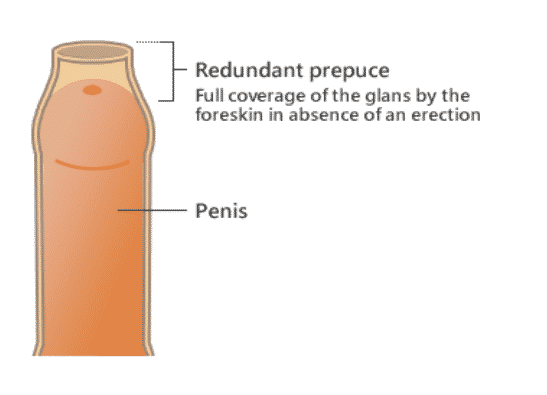Fact checked by Dr. Abdol Rashid Bin Masrom
Table of Contents
What is a Redundant Foreskin?

ZSR circumcision can help reducing foreskin problems>
The Redundant Foreskin is the excess amount of foreskin covering the head of a male penis completely before its erected. This skin often leads to numerous health problems, especially if the male cannot completely withdraw the foreskin from the head of the penis. Such people will require visiting a urologist for enhanced examination and treatment to prevent significant health issues.
When the foreskin grows in excess, it is called the redundant foreskin or redundant prepuce. Therefore, it requires a medical procedure or surgery to correct the problem and prevent further development of health issues due to the foreskin.
Therefore, one with excess foreskin will require a surgical procedure (circumcision) to remove the excess skin and regain personal confidence. Less than 10% of the boys are circumcised in Australia. It is mostly done based on family requires religion or cultural reasons. However, it is highly recommended, especially for older boys or men who frequently have infections or other foreskin problems that don’t respond to treatment.
What is a Foreskin?
The skin that covers the head of a penis is called the foreskin. It requires regular cleaning to prevent the buildup of a whitish-yellow substance, which is also known as smegma that occurs under the skin. Excess buildup of this substance can cause infection.
At birth, the foreskin is attached to the penis fully, and it starts to separate or be retracted at the age of two, although it can even begin later. However, there are instances when it doesn’t separate evenly, but this is a problem that resolves with puberty.

Causes of the Redundant Foreskin
The redundant foreskin is a common condition that occurs when there is too much skin left behind during circumcision. The extra skin causes adhesion, or it covers the head of the penis completely such that one doesn’t look circumcised.
Therefore, the problems that would previously develop due to being uncircumcised will gradually start developing, increasing the chances of infections or other related health issues. So, when going for the circumcision, you ensure that your urologist is certified and has the required skills to perform circumcision to avoid such problems.
Symptoms and Diagnosis for Redundant Foreskin
For you to know if you have a redundant foreskin, they mostly appear near the foreskin and head of the penis, and they often range from mild to severe. It also makes you feel uncomfortable while urinating or having sexual intercourse. However, other symptoms related to the problem include:
– Dry skin
– Discolored or shiny skin
– Pain, irritation, and tenderness
– Unusual discharge
– Burning or itching
– Foul smell
– Thick, leathery skin
– Tight foreskin
– Skin erosion or lesions
The symptoms vary from one person to the other and depending on the cause of the problem. Additionally, the symptoms will combine differently, making it difficult to tell whether a person has a redundant foreskin problem. However, a common combination includes burning, itching, and white discoloration around the foreskin and penis head.
The diagnosis of this condition will require a urologist. You might also be forced to see a dermatologist as the problem may present as a skin condition. The doctor will then have to perform some tests, including blood tests, to ensure they rule out other severe conditions that could be developing in disguise to the redundant foreskin.
Therefore, your doctor will require taking a sample of the skin and examining it under a microscope. In some cases, depending on the type of results your doctor finds, it might also be necessary to perform a biopsy in the process of diagnosing. However, this condition is not a problem by itself. Therefore, in diagnosis, the urologist will focus more on identifying and treating the cause of the symptoms you show. For instance, if you experience irritation, the doctor will determine the cause of the irritation and recommend treatment.
Who is Likely to Have a Redundant Foreskin?
The redundant foreskin is a common condition that affects boys and men in different stages of life. However, a person who has gone through circumcision, and it did not go as it should is more likely to have the problem. When the foreskin doesn’t pull back and forth, it makes cleaning your penis a little challenging. This, therefore, leads to the development of smegma or whitish-yellow substance around the penis head.
What Not to Do if You Have Redundant Foreskint?
If you have this problem, you need to visit a urologist once you have taken care of your hygiene. Your urologist will examine and recommend possible treatment measures and restore order to your manhood.
Types of Treatments
There is a wide range of treatment options depending on the cause and the intensity of the problem. Commonly, treating the underlying symptoms can help clear the issue and speed up the recovery process. However, there are times when the patient will require antibiotics and antifungal prescription as a form of treatment.
If the cause for the problem is the increased foreskin, then going for a second circumcision could be the best treatment option.
The preferable option is the ZSR circumcision procedure. It is painless and only takes less than 10 minutes to complete. The procedure has the shortest recovery period, unlike any other mode of circumcision, and is known to work best for redundant foreskin. It involves using a ZSR circumcision device to take off the foreskin and place small metal clips that will fall off automatically after a few days.
Final Thought
Taking care of your health as a man should not be optional at any given time; whenever you experience anything unusual around the penis or foreskin, it is essential to communicate to your urologist for professional assistance.
After all, this is a very crucial part of your body that ensuring that you have a continued generation.
- Nano Medic Care
